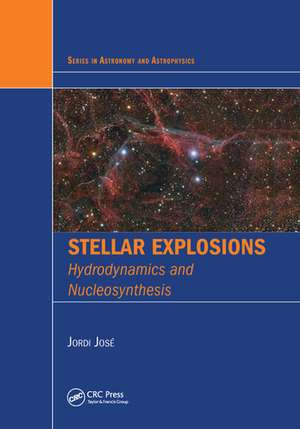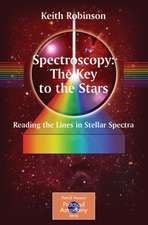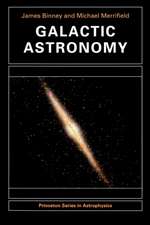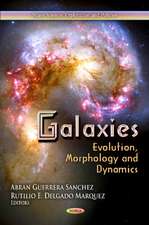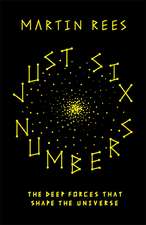Stellar Explosions: Hydrodynamics and Nucleosynthesis: Series in Astronomy and Astrophysics
Autor Jordi Joseen Limba Engleză Paperback – 30 iun 2020
The study of the physics of the stars and their role as nucleosynthesis factories owes much to cross-fertilization of different, somehow disconnected fields, ranging from observational astronomy, computational astrophysics, and cosmochemistry to experimental and theoretical nuclear physics. Few books have simultaneously addressed the multidisciplinary nature of this field in an engaging way suitable for students and young scientists.
Providing the required multidisciplinary background in a coherent way has been the driving force for Stellar Explosions: Hydrodynamics and Nucleosynthesis. Written by a specialist in stellar astrophysics, this book presents a rigorous but accessible treatment of the physics of stellar explosions from a multidisciplinary perspective at the crossroads of computational astrophysics, observational astronomy, cosmochemistry, and nuclear physics. Basic concepts from all these different fields are applied to the study of classical and recurrent novae, type I and II supernovae, X-ray bursts and superbursts, and stellar mergers. The book shows how a multidisciplinary approach has been instrumental in our understanding of nucleosynthesis in stars, particularly during explosive events.
| Toate formatele și edițiile | Preț | Express |
|---|---|---|
| Paperback (1) | 451.54 lei 6-8 săpt. | |
| CRC Press – 30 iun 2020 | 451.54 lei 6-8 săpt. | |
| Hardback (1) | 1346.03 lei 6-8 săpt. | |
| CRC Press – 22 dec 2015 | 1346.03 lei 6-8 săpt. |
Din seria Series in Astronomy and Astrophysics
-
 Preț: 357.42 lei
Preț: 357.42 lei - 8%
 Preț: 440.66 lei
Preț: 440.66 lei -
 Preț: 371.71 lei
Preț: 371.71 lei -
 Preț: 361.71 lei
Preț: 361.71 lei - 30%
 Preț: 854.01 lei
Preț: 854.01 lei - 23%
 Preț: 427.41 lei
Preț: 427.41 lei - 25%
 Preț: 358.44 lei
Preț: 358.44 lei - 29%
 Preț: 1349.89 lei
Preț: 1349.89 lei - 15%
 Preț: 552.83 lei
Preț: 552.83 lei - 29%
 Preț: 600.46 lei
Preț: 600.46 lei -
 Preț: 360.96 lei
Preț: 360.96 lei -
 Preț: 359.44 lei
Preț: 359.44 lei -
 Preț: 436.36 lei
Preț: 436.36 lei -
 Preț: 450.02 lei
Preț: 450.02 lei -
 Preț: 430.80 lei
Preț: 430.80 lei - 27%
 Preț: 496.94 lei
Preț: 496.94 lei -
 Preț: 358.81 lei
Preț: 358.81 lei -
 Preț: 482.28 lei
Preț: 482.28 lei - 23%
 Preț: 456.70 lei
Preț: 456.70 lei
Preț: 451.54 lei
Nou
Puncte Express: 677
Preț estimativ în valută:
86.43€ • 93.91$ • 72.65£
86.43€ • 93.91$ • 72.65£
Carte tipărită la comandă
Livrare economică 22 aprilie-06 mai
Preluare comenzi: 021 569.72.76
Specificații
ISBN-13: 9780367575151
ISBN-10: 0367575159
Pagini: 472
Dimensiuni: 178 x 254 x 24 mm
Greutate: 0.82 kg
Ediția:1
Editura: CRC Press
Colecția CRC Press
Seria Series in Astronomy and Astrophysics
ISBN-10: 0367575159
Pagini: 472
Dimensiuni: 178 x 254 x 24 mm
Greutate: 0.82 kg
Ediția:1
Editura: CRC Press
Colecția CRC Press
Seria Series in Astronomy and Astrophysics
Cuprins
Computational Hydrodynamics. Nuclear Physics. Cosmochemistry and Presolar Grains. Classical and Recurrent Novae. Type Ia Supernovae. X-Ray Bursts and Superbursts. Core-Collapse Supernovae. Appendices.
Notă biografică
Jordi José is a professor of applied physics and currently the director of the Department of Physics at the Technical University of Catalonia (UPC) in Barcelona. He is also a research associate at the Institute for Space Studies of Catalonia (IEEC). He has been a referee for many research journals and funding agencies (including the U.S. Department of Energy). Dr. José has also been leading a number of international research initiatives, such as the EuroGENESIS program (European Science Foundation). His research focuses on stellar explosions at the crossroads of astrophysics, hydrodynamics, nuclear physics, and cosmochemistry. He is a member of the International Astronomical Union (IAU), the American Physical Society (APS), the Sociedad Española de Astronomía (SEA), and the Societat Catalana de Física, among others.
Recenzii
"The text is well-written throughout and treats the topic with mathematical rigour. It is fully referenced to scientific publications, mostly journal articles...the book features end-of-chapter problems with solutions available on the corresponding CRC website. As a nice feature, there are also end-of-chapter boxes with the main take-home messages and open scientific problems for each topic. The text is illustrated by numerous black and white figures and photographs...Owing to this breadth of scientific work involved in the discussion, the book may not only be recommended as a textbook for students taking a corresponding course within astronomy or astrophysics, but also as a reference for more advanced readers."
—Manuel Vogel, in Contemporary Physics (October 2016)
"In this thorough textbook, José uniquely and ambitiously addresses stellar astrophysics from a theoretical, a computational, and an observational perspective. The book is written to introduce astronomers to underlying nuclear physics and to introduce physicists to the observational astronomy of these systems. Many researchers utilize advanced computational modeling to study phenomena such as novae and supernovae; José presents an excellent overview of the types of codes used as well as the advantages and disadvantages of each. Along with the appendix, a sample FORTRAN code, useful for learning the techniques in more advanced codes, is presented. For researchers studying stellar explosions and their connection to the creation of elements in the universe, each chapter provides derivations and quantitative analysis necessary to understand astronomical observations of these phenomena. Models are also used to interpret the observations. Helpful features within the text are chapters ending with a summary and a page of unsolved problems currently under investigation in the astronomical community."
— Dr. C. Palma, Pennsylvania State University, in Choice (October 2016)
"This is just the book that I wish had been available when I started in this research area. An authoritative account of the field, covering the three pillars—observation, modeling, and nuclear physics. All three areas are covered in extensive detail, with wonderfully comprehensive references to a wealth of important publications. There are also many interesting and informative footnotes that provide fascinating detail on how ideas emerged and give life to the narrative. I am jealous of those who will follow us in this wonderful research endeavor as this book will provide them with a rapid and comprehensive introduction. It also provides a detailed understanding for those of us already active in the field."
—Dr. Brian Fulton, Professor, University of York, UK
"This is a lucid, engaging, and comprehensive survey by a masterful guide of a rapidly expanding territory. Dr. José succeeds remarkably in linking the many classes of explosive stellar phenomena with careful attention to the theoretical (and modeling) details and observational and laboratory consequences. It is especially timely since the exploration of the time variable Universe has just begun, with rapid response satellites, ground-based robotic telescopes, and anticipated projects such as the Large Synoptic Survey Telescope. This book provides the tools and the context."
—Dr. Steven N. Shore, Professor, University of Pisa, Italy, and Editor of Astronomy & Astrophysics
"This exciting book describes in vivid detail how much of the baryonic mass of the Universe is being cycled through stars. The descriptions of the violent explosions and deaths of stars, and how these events forge and release the heavy elements needed for life, are extremely clear and compelling. This book belongs in the library of every stellar astrophysicist."
—Dr. Michael Shara, Curator, American Museum of Natural History, New York, USA
"Dr. Jordi José takes us on a journey from scholarly physics through the microcosmos of atomic nuclei to the places where they were built, the stars and their explosions of the macrocosmos, and the vastness of our universe. With wit and sense for cultural context and history, the scientific methods and tools are made accessible to a broad audience to stimulate our natural curiosity and the student in each of us. This fascinating book grounds the reader by tightening the connections to our cosmic origins."
—Dr. Roland Diehl, Professor, Max Planck Institute for Extraterrestrial Physics, Garching, Germany
"This book deftly explains a wide range of interrelated topics, including the nuts and bolts of hydrodynamic simulations, nuclear physics, laboratory measurements of meteorites, and various types of stellar explosions observed in the Universe. Professor José has written a fantastic resource for students and professional scientists alike working at the interdisciplinary crossroads of stellar astrophysics and meteorite science."
—Dr. Larry N. Nittler, Staff Scientist, Carnegie Institution of Washington, USA
"Our understanding of the processes that drive the gradual changes in the composition of the Universe has recently undergone a phase of expansion so fast that, like most of the topics discussed in this book, it might be really defined as being explosive. This revolution has accompanied the turn of the century and has been fed by a combination of at least three different developments. Two of them lay in the progress made by theoretical and experimental (especially nuclear) physics, as applied to describe the behavior of stellar plasmas. The third comes instead from computer technology, which has permitted an astonishing growth in computing capabilities, without which the enormously time-consuming calculations required to model the hydrodynamics and nucleosynthesis of explosive stellar events would have simply been unfeasible.
Despite the importance and complementarity of each development, however, it has so far been impossible to find in a unique place the comprehensive and clear presentation of all the ingredients that this text offers. In fact, this book fills the gap and places itself at the top of modern literature on the physics of stars, in particular, of their explosive phenomena. The reader finds a beautiful blend, including an account of modern hydrodynamical methods, an up-to-date description of our knowledge of the relevant stellar nuclear processes, and a detailed analysis of ‘how things are done’ in modern computer science. Due to these qualities, this is a superb book in modern physics, not only in astrophysics. In an era in which a large part of the attention of physicists is devoted to fundamental interactions in search for the unification of the forces of nature, this is a loud and authoritative voice that reminds all of us how the complementary task of making stars known in detail remains one of the most important commitments of our generation.
Professionals in stellar astrophysics and graduate students can find here not only a precious reference source of information with a rare quality and clarity but also, and probably more important, a remarkable account of how the physics of stars has developed into a legacy to the future, something that goes behind its great scientific results and represents one of the most important intellectual achievements of modern culture."
—Dr. Maurizio Busso, Professor, University of Perugia, Italy
"This book is destined to ignite the flame of curiosity and excitement in the reader and will no doubt play a major role in motivating the next generation of stellar astrophysicists. I am confident that this masterful account will become a cornerstone for stellar astrophysics education."
—From the Foreword by Christian Iliadis, Professor of Physics and Astronomy, University of North Carolina at Chapel Hill, USA
—Manuel Vogel, in Contemporary Physics (October 2016)
"In this thorough textbook, José uniquely and ambitiously addresses stellar astrophysics from a theoretical, a computational, and an observational perspective. The book is written to introduce astronomers to underlying nuclear physics and to introduce physicists to the observational astronomy of these systems. Many researchers utilize advanced computational modeling to study phenomena such as novae and supernovae; José presents an excellent overview of the types of codes used as well as the advantages and disadvantages of each. Along with the appendix, a sample FORTRAN code, useful for learning the techniques in more advanced codes, is presented. For researchers studying stellar explosions and their connection to the creation of elements in the universe, each chapter provides derivations and quantitative analysis necessary to understand astronomical observations of these phenomena. Models are also used to interpret the observations. Helpful features within the text are chapters ending with a summary and a page of unsolved problems currently under investigation in the astronomical community."
— Dr. C. Palma, Pennsylvania State University, in Choice (October 2016)
"This is just the book that I wish had been available when I started in this research area. An authoritative account of the field, covering the three pillars—observation, modeling, and nuclear physics. All three areas are covered in extensive detail, with wonderfully comprehensive references to a wealth of important publications. There are also many interesting and informative footnotes that provide fascinating detail on how ideas emerged and give life to the narrative. I am jealous of those who will follow us in this wonderful research endeavor as this book will provide them with a rapid and comprehensive introduction. It also provides a detailed understanding for those of us already active in the field."
—Dr. Brian Fulton, Professor, University of York, UK
"This is a lucid, engaging, and comprehensive survey by a masterful guide of a rapidly expanding territory. Dr. José succeeds remarkably in linking the many classes of explosive stellar phenomena with careful attention to the theoretical (and modeling) details and observational and laboratory consequences. It is especially timely since the exploration of the time variable Universe has just begun, with rapid response satellites, ground-based robotic telescopes, and anticipated projects such as the Large Synoptic Survey Telescope. This book provides the tools and the context."
—Dr. Steven N. Shore, Professor, University of Pisa, Italy, and Editor of Astronomy & Astrophysics
"This exciting book describes in vivid detail how much of the baryonic mass of the Universe is being cycled through stars. The descriptions of the violent explosions and deaths of stars, and how these events forge and release the heavy elements needed for life, are extremely clear and compelling. This book belongs in the library of every stellar astrophysicist."
—Dr. Michael Shara, Curator, American Museum of Natural History, New York, USA
"Dr. Jordi José takes us on a journey from scholarly physics through the microcosmos of atomic nuclei to the places where they were built, the stars and their explosions of the macrocosmos, and the vastness of our universe. With wit and sense for cultural context and history, the scientific methods and tools are made accessible to a broad audience to stimulate our natural curiosity and the student in each of us. This fascinating book grounds the reader by tightening the connections to our cosmic origins."
—Dr. Roland Diehl, Professor, Max Planck Institute for Extraterrestrial Physics, Garching, Germany
"This book deftly explains a wide range of interrelated topics, including the nuts and bolts of hydrodynamic simulations, nuclear physics, laboratory measurements of meteorites, and various types of stellar explosions observed in the Universe. Professor José has written a fantastic resource for students and professional scientists alike working at the interdisciplinary crossroads of stellar astrophysics and meteorite science."
—Dr. Larry N. Nittler, Staff Scientist, Carnegie Institution of Washington, USA
"Our understanding of the processes that drive the gradual changes in the composition of the Universe has recently undergone a phase of expansion so fast that, like most of the topics discussed in this book, it might be really defined as being explosive. This revolution has accompanied the turn of the century and has been fed by a combination of at least three different developments. Two of them lay in the progress made by theoretical and experimental (especially nuclear) physics, as applied to describe the behavior of stellar plasmas. The third comes instead from computer technology, which has permitted an astonishing growth in computing capabilities, without which the enormously time-consuming calculations required to model the hydrodynamics and nucleosynthesis of explosive stellar events would have simply been unfeasible.
Despite the importance and complementarity of each development, however, it has so far been impossible to find in a unique place the comprehensive and clear presentation of all the ingredients that this text offers. In fact, this book fills the gap and places itself at the top of modern literature on the physics of stars, in particular, of their explosive phenomena. The reader finds a beautiful blend, including an account of modern hydrodynamical methods, an up-to-date description of our knowledge of the relevant stellar nuclear processes, and a detailed analysis of ‘how things are done’ in modern computer science. Due to these qualities, this is a superb book in modern physics, not only in astrophysics. In an era in which a large part of the attention of physicists is devoted to fundamental interactions in search for the unification of the forces of nature, this is a loud and authoritative voice that reminds all of us how the complementary task of making stars known in detail remains one of the most important commitments of our generation.
Professionals in stellar astrophysics and graduate students can find here not only a precious reference source of information with a rare quality and clarity but also, and probably more important, a remarkable account of how the physics of stars has developed into a legacy to the future, something that goes behind its great scientific results and represents one of the most important intellectual achievements of modern culture."
—Dr. Maurizio Busso, Professor, University of Perugia, Italy
"This book is destined to ignite the flame of curiosity and excitement in the reader and will no doubt play a major role in motivating the next generation of stellar astrophysicists. I am confident that this masterful account will become a cornerstone for stellar astrophysics education."
—From the Foreword by Christian Iliadis, Professor of Physics and Astronomy, University of North Carolina at Chapel Hill, USA
Descriere
Written by a specialist in stellar astrophysics, this book presents a rigorous but accessible treatment of the physics of stellar explosions from a multidisciplinary perspective at the crossroads of computational astrophysics, observational astronomy, cosmochemistry, and nuclear physics. Basic concepts from all these different fields are applied
